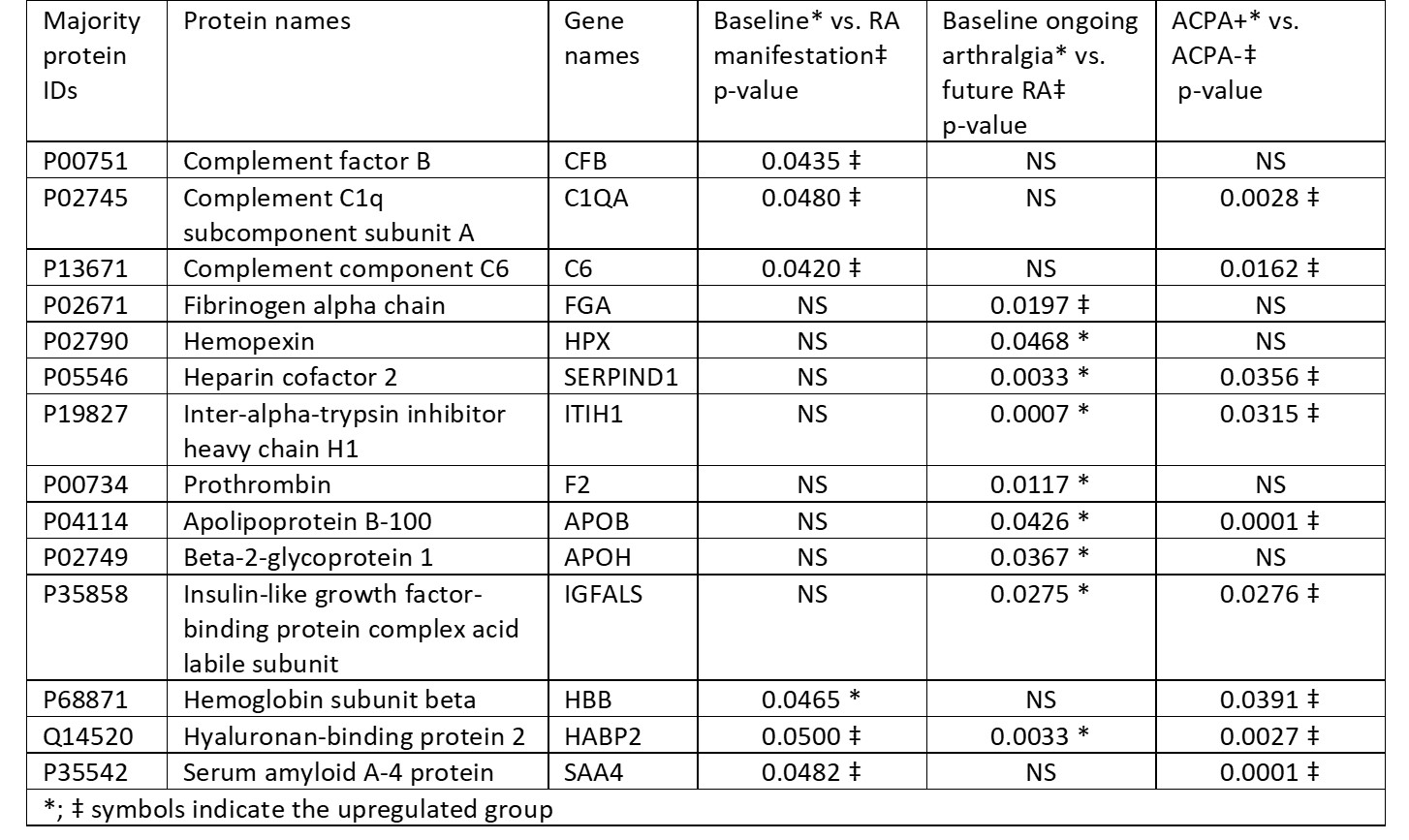Session Information
Date: Saturday, November 7, 2020
Title: RA – Diagnosis, Manifestations, & Outcomes Poster II: Biomarkers
Session Type: Poster Session B
Session Time: 9:00AM-11:00AM
Background/Purpose: The presence of antibodies against citrullinated proteins (ACPA) significantly increases the risk of developing rheumatoid arthritis (RA). EULAR characterised individuals with arthralgia suspicious for progression to RA based on their clinical features (clinically suspect arthralgia, CSA). We aimed to analyse proteins at different stages of RA development with special interest in the at-risk individuals with arthralgia.
Methods: Plasma samples were obtained from 28 at-risk individuals with arthralgia and no previous history of arthritis, who were either ACPA+ or met the CSA definition. Samples collected at baseline or at the time of manifestation of arthritis were analysed by tandem mass spectrometry (nLC-MS2) using Q-OT-qIT mass spectrometer (Thermo ScientificTM) followed by MaxQuant software quantification and normalization. Data were analysed using Mann Whitney or Wilcoxon pairs tests and presented as median and interquartile range [IQR]. Protein interaction networks were analysed using STRING v11.0.
Results: Out of 28 individuals with arthralgia (96% females), 13 were ACPA+ and 23 met the CSA definition (8 were ACPA+). Median age was 47 [15] years, median symptom duration 12 [17] months and CRP 3.18 [3.56] mg/L. Thirteen individuals developed RA (10 were ACPA+) within a median of 7 months of follow up with CRP 3.25 [13.10] mg/l and DAS28(CRP) score 4.39 [2.18].
Out of 393 identified proteins, 90 proteins were detected in all tested samples. In individuals who progressed to RA, 6 proteins were differentially expressed at baseline and the manifestation of arthritis (Table 1): complement factor B (CFB), complement C1q subcomponent subunit A (C1QA) and complement component C6 were significantly higher at the time of RA onset. Protein interaction network linked C1QA to C6 by CFB. Moreover, these proteins are involved in innate immune response and regulation of acute inflammatory response. Hemoglobin subunit beta (HBB) was significantly lower at the time of RA onset.
Nine proteins showed differential baseline expression between individuals with ongoing arthralgia (median follow up 12 months) and individuals who have developed RA (Table 1): fibrinogen alpha chain (FGA) was significantly higher in future RA patients while heparin cofactor 2 (SERPIND1), prothrombin (F2), apolipoprotein B-100 (APOB) and beta-2 glycoprotein 1 (APOH) were significantly lower compared to individuals with ongoing arthralgia. Protein interaction networks linked all these four proteins involved in metabolic processes.
Nine proteins were differentially expressed at baseline between ACPA+ and ACPA- individuals (Table 1).
Conclusion: Using proteome analysis we identified several differentially expressed proteins in the at-risk individuals with arthralgia during the progression to RA that were mostly involved in innate immune and acute inflammatory response. Their predictive value as prognostic biomarkers for future development of RA in the at-risk individuals with arthralgia needs to be confirmed in larger patient cohorts.
 Table 1: List of differentially expressed proteins
Table 1: List of differentially expressed proteins
To cite this abstract in AMA style:
Prajzlerová K, Petrovská N, Gregová M, Baloun J, Hánová P, Pavelka K, Vencovský J, Šenolt L, Filková M. Plasmatic Proteome in Individuals with Arthralgia at Risk of Developing Rheumatoid Arthritis [abstract]. Arthritis Rheumatol. 2020; 72 (suppl 10). https://acrabstracts.org/abstract/plasmatic-proteome-in-individuals-with-arthralgia-at-risk-of-developing-rheumatoid-arthritis/. Accessed .« Back to ACR Convergence 2020
ACR Meeting Abstracts - https://acrabstracts.org/abstract/plasmatic-proteome-in-individuals-with-arthralgia-at-risk-of-developing-rheumatoid-arthritis/
